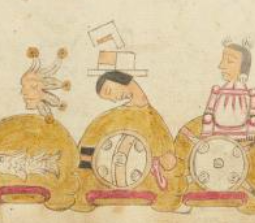Tolocan (Azca25)
This painted black-line drawing of the compound glyph for the place name Tolocan. It features a golden hill or mountain with horizontal gold and red slits at the bottom where a natural spring might emerge. The hill is something of a visual locative for the suffix -can in the place name. On top of the mountain is a profile view of a man’s head, facing left and downward. The head is lowered or bowing (toloa), which provides the principal logogram for the place name. The man’s eye is closed, suggesting death. On the front of the mountain is a war shield and a macuahuitl (wooden club embedded with obsidian blades), suggestive of war. Also visible in the contextualizing image is a temple that is broken, the top half tipping over, a symbol of tepehualiztli (the defeat and subjugation of a town).
Stephanie Wood
Given the lack of a gloss identifying this place name, we might have called this an example of iconography. But see the Tolocan glyphs, below, which also have bowing heads. Based upon these similarities and the context, we are fairly certain of the identification of this altepetl. The hill or mountain for this compound place glyph is obscured a little on the left side by the neighboring glyph, which also has a hill or mountain.
Stephanie Wood
post-1550, possibly from the early seventeenth century.
Jeff Haskett-Wood
pueblos, topónimos, nombres de lugares

toloa, to bow or lower the head, https://nahuatl.wired-humanities.org/content/toloa
-can (locative suffix), where, https://nahuatl.wired-humanities.org/content/can-2
The Codex Azcatitlan is also known as the Histoire mexicaine, [Manuscrit] Mexicain 59–64. It is housed in the Bibliothèque Nationale de France, and hosted on line by the World Digital Library and the Library of Congress, which is “unaware of any copyright or other restrictions in the World Digital Library Collection.”
https://www.loc.gov/resource/gdcwdl.wdl_15280/?sp=25&st=image
The Library of Congress is “unaware of any copyright or other restrictions in the World Digital Library Collection.” But please cite Bibliothèque Nationale de France and this Visual Lexicon of Aztec Hieroglyphs.



